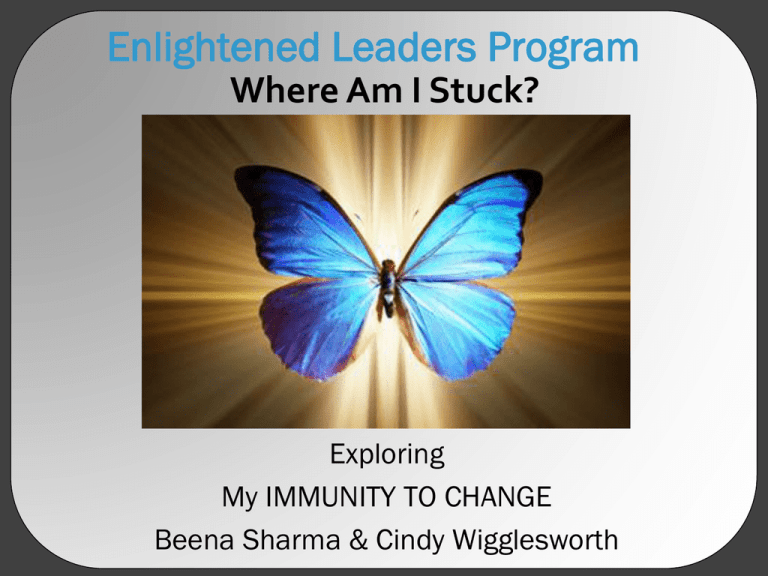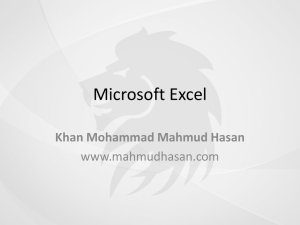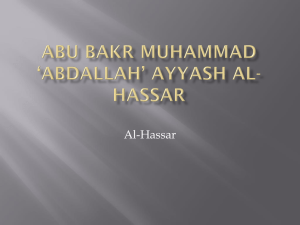
Enlightened Leaders Program
Where Am I Stuck?
Exploring
My IMMUNITY TO CHANGE
Beena Sharma & Cindy Wigglesworth
Specific Learning Objectives
To identify, explore and create a plan to
achieve a self development goal
To learn and practice the Immunity to Change
(which we will refer to as ‘ITC’) tool, and be
able to use it in service of self and others
Copyright: B Sharma, C Wigglesworth
Larger purpose
To appreciate and facilitate the relationship
between personal change work and spiritual
intelligence
To become more effective change agents and
change leaders in the service of Unity and its
mission
Copyright: B Sharma, C Wigglesworth
Aim of the ITC tool
Accomplish personal improvements which
appear resistant to prior efforts
Copyright: B Sharma, C Wigglesworth
ITC Process
Creates a personal map or diagnostic of the
‘immunity to change’ as it relates to the personal
improvement goal
– i.e. engages me to deeply explore and elaborate
“what really prevents me from making the shifts I
so want to make?”
Copyright: B Sharma, C Wigglesworth
Why is this important?
If I am not effective in making personal, internal
shifts—I have less power to impact my external
world
Mastering the science and art of personal
change enables me to be a wiser and more
compassionate change agent in the world
Copyright: B Sharma, C Wigglesworth
ITC tool—simple and deep
Set of reflective questions on a worksheet
Including debrief with a learning partner (post
webinar)
Copyright: B Sharma, C Wigglesworth
The ITC tool works for you by:
1. Surfacing internal contradictions
2. Surfacing operating assumptions you take-astruths—which may be possibly faulty
3. Revealing how you may be unwittingly
working against realizing your personal
aspirations
Copyright: B Sharma, C Wigglesworth
Jumping In
We are going to jump in and start
swimming!
We will role play a sample worksheet (Jane’s
worksheet), step by step
You (webinar participants) can follow with
your personal reflection, with each step
Copyright: B Sharma, C Wigglesworth
The Worksheet Template
COLUMN 1
COLUMN 2
COLUMN 3
COLUMN 4
Improvement
Goal
Doing / Not Doing
Hidden Competing
Commitment
Big Assumption
© Minds at Work
Copyright: B Sharma, C Wigglesworth
Column 1.
Review pre-work and pick a goal
Take a few minutes to refer to your Reflection from the Prework (A) which had 4 questions
Go over all the responses and pick key areas in response to
the question: “From all the feedback from my reflection, what
are one or two arenas that, if I were to improve in, would lead
me to be more effective than I currently am, and enable me to
reach my vision of who I want to be?”
Think about these arenas – and generate or craft a few
potential improvement goals (identify 2 – 4 goals)
Copyright: B Sharma, C Wigglesworth
Copyright: B Sharma, C Wigglesworth
Criteria for high-quality
Column 1 entries
Now, pick one goal to work on today.
Use the following criteria to select your goal:
It’s true for you
It implicates you (you are on the hook)
There’s room for improvement
It’s important to you
Copyright: B Sharma, C Wigglesworth
Column 1
Improvement Goal
To take better
care of myself (not
be so stressed,
exercise more, have
more time to relax)
© Minds at Work
JANE’S WORKSHEET
Column 2.
What am I doing or not doing which has the
effect (directly or inadvertently) of
undermining or working against my own First
Column Commitment?
Copyright: B Sharma, C Wigglesworth
Criteria for high-quality
Column 2 entries
Names behaviors, not just dispositions (not
“I’m uncomfortable with conflict,” but what
you do or don’t do as a result)
Clear how it undermines or works against the
column #1 commitment
Not why or what you should do about it—just
the behaviors and non-behaviors
Copyright: B Sharma, C Wigglesworth
Column 1
Column 2
Improvement Goal
Doing/Not Doing
To take better
care of myself (not
be so stressed,
exercise more, have
more time to relax)
I don’t say ‘No’
enough
I say “Yes” without
thinking it through
I don’t ask for help
I schedule time for
the gym but am too
busy to go when the
time comes
© Minds at Work
JANE’S WORKSHEET
Column 3—PART 1
1. Consider doing the opposite of the behaviors you
have just named...
• That is, if you do something now that gets in your way,
•
what if you didn’t do that?
And, if you don’t do something now, what if you did do
that?
2. See if you can identify a fear or a worry that comes
up—what concerns do you have? What do you worry
would happen?
Copyright: B Sharma, C Wigglesworth
Column 1
Column 2
Column 3 – 2 parts
Improvement Goal
Doing/Not Doing
Hidden Competing
Commitment
To take better
care of myself (not
be so stressed,
exercise more, have
more time to relax)
I don’t say ‘No’
enough
PART 1: Worry/Fear
Box: people would
stop needing me;
others, not me, would
get the credit
I say “Yes” without
thinking it through
I don’t ask for help
I schedule time for
the gym but am too
busy to go when the
time comes
© Minds at Work
JANE’S WORKSHEET
Column 3 – PART 2
1. Now, consider that you are committed to actively
prevent these fears from being actualized—you
really don’t want to experience those things you
worry about.
2. So—can you identify what these commitments are
that you have, to protect yourself?
Copyright: B Sharma, C Wigglesworth
Criteria for high-quality
Column 3 entries
It’s a commitment to self-protection (vs.
“Noble”)
It shows you why the “second column
behaviors” make all the sense in the world!
Feels powerful (‘4’ or ‘5’ on 1-5 scale)
Copyright: B Sharma, C Wigglesworth
Column 1
Column 2
Column 3 – 2 parts
Improvement Goal
Doing/Not Doing
Hidden Competing
Commitment
To take better
care of myself (not
be so stressed,
exercise more, have
more time to relax)
I don’t say ‘No’
enough
PART 1: Worry/Fear
Box: people would
stop needing me;
others, not me, would
get the credit
I say “Yes” without
thinking it through
I don’t ask for help
I schedule time for
the gym but am too
busy to go when the
time comes
PART 2:
To being completely
available all the time
To feeling
Indispensable / to
being seen as
indispensable
To getting the credit
To being counted on
© Minds at Work
JANE’S WORKSHEET
Column 4
1. Look at your Column 3 commitment.
2. Ask yourself what assumptions must I be
making that would keep me captive to this
commitment?
Copyright: B Sharma, C Wigglesworth
How to fill in Column 4
Complete the sentence:
“I assume that....if I don’t keep to my column 3
commitment, then...” (fill in a dire consequence)
Example: If I am not always available, then I
wont be the ‘go to’ person and no one will want
me
Copyright: B Sharma, C Wigglesworth
Criteria for high-quality
Column 4 entries
It makes the 3rd column
commitment absolutely necessary
It has a “big-time bad” conclusion
Copyright: B Sharma, C Wigglesworth
Column 1
Column 2
Column 3 – 2 parts
Column 4
Improvement Goal
Doing/Not Doing
Hidden Competing
Commitment
Big Assumption
To take better
care of myself (not
be so stressed,
exercise more, have
more time to relax)
I don’t say ‘No’
enough
PART 1: Worry/Fear
Box: people would
stop needing me;
others, not me, would
get the credit
If I’m not always
available, then I won’t be
the “go to” person, and no
one would want me
I say “Yes” without
thinking it through
I don’t ask for help
I schedule time for
the gym but am too
busy to go when the
time comes
PART 2:
To being completely
available all the time My value depends on
“doing”
To feeling
Indispensable / to
being seen as
indispensable
To getting the credit
To being counted on
© Minds at Work
If I’m not indispensable
I’m 2nd rate, or I am
worthless.
JANE’S WORKSHEET
If I don’t get the credit, I’ll
lose out on future
opportunities
Feeling indispensable &
getting the credit are more
important to me than
taking care of myself
What we have done so far
Column 1
Column 2
Improvement
Goal
Doing/ Not Hidden
Competing
Doing
Commitment
© Minds at Work
Column 3 in 2 parts
Column 4
Big Assumption
The Gift of this process
UNCONSCIOUSLY “IMMUNE”
CONSCIOUSLY “IMMUNE”
CONSCIOUSLY “RELEASED”
UNCONSCIOUSLY“RELEASED”
The Gift of this process
UNCONSCIOUSLY “IMMUNE”
CONSCIOUSLY “IMMUNE”
Follow-up work to overturning your “immune system”
- Designing and evaluating tests
CONSCIOUSLY “RELEASED”
UNCONSCIOUSLY“RELEASED”
Column 5!
Growing Consciously Immune
Follow Up Work (COLUMN 5) To Overturning Your “Immune System”
Step 1: Observe The Big Assumption In Action
Step 2: Stay Alert To Natural Challenges & Counters To The Big
Assumption
Step 3: Write The Biography Of Your Big Assumption
Step 4: Design A First Test Of Your Big Assumption
Step 5: Examine The Results Of Your First Test
Step 6: Develop / Run / Evaluate Further Tests
Copyright: B Sharma, C Wigglesworth
Column 5
Design your experiment
Think about a couple of experiments you will
conduct to test the truth or validity of your Big
Assumption
Use the following criteria to design your
experiment:
Safe, low risk situation
Doable – without prohibitive effort
Specific and actionable
Copyright: B Sharma, C Wigglesworth
The ITC (Immunity to Change) Worksheet
COLUMN 5
My Experiments and Observations
1. For the month of September, I am going to say ‘NO’ in 3
situations where I would normally say ‘YES.’ I will do this by
carefully thinking through my priorities so I focus on what
would best meet my longer term vision.
2. For the month of October, I am going to ‘ask for help’ in in
3 situations where I would normally go ahead and do
whatever was needed by myself.
JANE’S WORKSHEET
Summarizing
Stepping back to get an overview of
what we have done, and how the
Immunity to Change process works
Copyright: B Sharma, C Wigglesworth
What’s keeping me stuck??
Copyright: B Sharma, C Wigglesworth
You have tried to
change and grow,
in your effort to
shift some deep
seated patterns...
Is this feeling
familiar to you?
You can see the
light, but can’t
get to it!
Copyright: B Sharma, C Wigglesworth
We know changing one’s habits or mindsets and living into
new ones is one the most difficult thing for a human being.
Because...
The roots are long and hidden,
what is under the surface is way
bigger than we know or imagine
Copyright: B Sharma, C Wigglesworth
The path to evolving
and growing out of
old habits involves
going beyond
surface thinking and
acting
Copyright: B Sharma, C Wigglesworth
Our Big Assumptions—the core of our universe
Exploring what is
at the molten core
of our beliefs, that
keeps our view of
the world fixed, is
a powerful way to
crack the code of
personal change!
Copyright: B Sharma, C Wigglesworth
Big
assumptions
are seldom
discussable,
because they
are rarely seeable.
Fish don’t talk
about the
water
Copyright: B Sharma, C Wigglesworth
Our Big Assumptions—are the invisible motors
that drive the bigger, visible behaviors that we
cannot change even if we try, because their motive
power comes from what we cannot see
Copyright: B Sharma, C Wigglesworth
This is the way we can unearth our authentic self, and can
be who we really are, and step by step, one by one,
resolve the contradictions we live with every day
Copyright: B Sharma, C Wigglesworth
The ITC process helps us reveal the thick fuzzy
invisible ‘thing’ that prevents us from making the
movement, and that we know for sure is there!
Copyright: B Sharma, C Wigglesworth
We have two competing commitments that are
inextricably linked together—and we are effectively in a
prison of our own making that we can’t see
Copyright: B Sharma, C Wigglesworth
Once we
‘unearth’ our
assumptions, we
can then, test
them against
reality. Are they
really true or
not? Are my
fears and worries
really
manifesting the
way I imagined
them, or....?
Copyright: B Sharma, C Wigglesworth
We can do this by releasing our inner scientist to
experiment—however now we are testing the inner
world not the outer world
Copyright: B Sharma, C Wigglesworth
Designing
experiments so we
can test our mental
models and what we
take as truths is a
robust way to
identify and release
those beliefs that are
faulty or erroneous
We have to be able to
see whether what we
hold to be true is
indeed true!
Copyright: B Sharma, C Wigglesworth
Testing is also
‘TASTING’
With ‘small’
experiments we can
begin to ‘taste’ and
experience the new
realities that we know
are there, but can’t
get to no matter how
hard we try!
Copyright: B Sharma, C Wigglesworth
We will now see how the Immunity to
Change process relates with
Polarity Management
and
Spiritual Intelligence
Copyright: B Sharma, C Wigglesworth
ITC and Polarities
• You may have felt the tensions between your
Column 1 goal (or value) and your Column 3
commitment (or value)
• Usually these two are a polarity you need to
manage
• Working with the Polarity Map can help you balance
and work simultaneously with both your
commitments
Copyright: B Sharma, C Wigglesworth
ITC and Polarities
• In the example we described today, we could map
the two values in a Polarity Map:
Values = positive results from focusing on the
left pole
Values = positive results from focusing on the
right pole
•
•
•
•
•
•
•
•
•
•
CARING FOR
MYSELF
BEING AVAILABLE
and
& COUNTED ON
•
•
•
•
•
•
•
•
•
•
Fears = negative results from over-focusing on
the left pole to the neglect of the right pole
Fears = negative results from over-focusing on
the right pole to the neglect of the left pole
Copyright: B Sharma, C Wigglesworth
ITC and Spiritual Intelligence
• When we deeply work with our big assumptions,
and become consciously released, it transforms us
and we become more ‘spiritually intelligent.’
• There are 21 skills that Cindy Wigglesworth has
defined in her book SQ 21. And by practicing the
ITC process along with polarity management, we
can directly impact specific skills.
• Let’s recap the definition of Spiritual Intelligence
Copyright: B Sharma, C Wigglesworth
What is Spiritual Intelligence?
Copyright: B Sharma, C Wigglesworth
21 Skills of SQ
Other focused
What Other People
See – Outer World
What You See Inner World
Self / self focused
1. Self / self Awareness
1.
2.
3.
4.
5.
Awareness of own worldview
Awareness of Life Purpose (Mission)
Awareness of Values Hierarchy
Complexity of inner thought
Awareness of Ego self/Higher Self
Commitment to spiritual growth
Keeping Higher Self in charge
Living your purpose and values
Sustaining faith
Seeking guidance from Higher
Power/ Higher Self
Calm, peaceful at all times
6.
7.
8.
Awareness of interconnectedness of life
Awareness of worldviews of others
Breadth of Time perception
9.
Awareness of limitations / power of
human perception
Awareness of Spiritual Laws
Experience of transcendent oneness
10.
11.
4. Social Mastery/Spiritual Presence
3. Self/self Mastery
12.
13.
14.
15.
16.
2. Universal Awareness
17. Wise and effective teacher / mentor
18. Wise and effective leader / change agent
19. Makes Compassionate AND Wise
20.
21.
decisions
A calming, healing presence
Being aligned with the ebb and flow of life
Compassionate and Wise Action
2004 Conscious Pursuits, Inc. Licensed to Deep Change, Inc. All Rights Reserved.
Copyright: B Sharma, C Wigglesworth
Quad 1 Skill 4: Complexity of Inner
Thought (not same as IQ)
1
I understand that rules are guidelines and sometimes a higher
principle requires that I break the rules. I understand that
decisions involving multiple people are complex.
2
I consider multiple points of view when I make decisions.
Knowing what is right and wrong is not a simple matter…for
example in biomedical ethics cases.
3
I understand there are no guaranteed outcomes for decisions I
have to make. I can make decisions in the face of insufficient
information.
4
I can see that two apparently conflicting points of view
can both contain elements of truth.
5
I enjoy thinking about complex and even conflicting ideas. I
can embrace paradox and mystery.
Copyright: B Sharma, C Wigglesworth
Quad 1 Skill 5: Awareness of Ego self /
Higher Self
1
I have a basic understanding that an ego self exists and that how it reacts to things
is a result of my personal experiences since birth, including the influence of my
family and my culture.
2
I can observe my own Ego in operation. I understand there is a difference between
the desires of my Ego and of my Higher Self.
3
I can recognize the situations and types of people that trigger my Ego self to want
to take charge. I recognize the signals my body gives me when my Ego has been
triggered.
4
I can consistently hear the voice of my Higher Self. This may be a “felt sense” in
the body, or an auditory or visual experience, or a combination. I may not hear it
often, but I know it when I do. I am learning to listen to it. I understand how my
thoughts and beliefs are creating the anger or fear I feel.
5
The voice of my Higher Self is now the principal voice I hear. Ego is now in joyful
service to Spirit. I no longer feel a “tug of war” between these two parts of my self.
Copyright: B Sharma, C Wigglesworth
In Appreciation and Gratitude
Beena And Cindy







